Bimota DB1
With Ian Falloon
During the 1980s Bimota had a reputation as one of the world’s leading specialist frame builders. Alongside providing World Championship winning racing frames for the Harley-Davidson and Yamaha two-stroke twins, Bimota also produced frames for Honda, Suzuki, and Kawasaki engines.
It wasn’t until 1985 that the first all-Italian Bimota appeared, the DB1 with a Ducati engine. The impetus for the DB1 came following Cagiva’s purchase of Ducati. After some years of negotiation, the Castiglioni brothers finally purchased Ducati Meccanica in 1985 from the Government controlled VM Group.
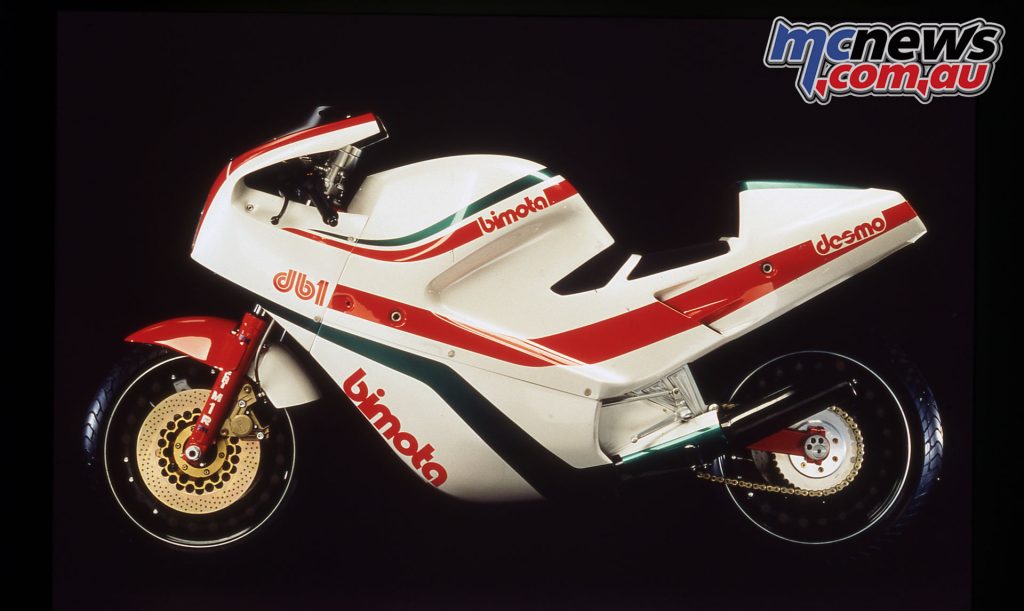
For Ducati the ramifications were immediately apparent. The expensive bevel-drive twins soon made an exit and the Castiglionis saw the future in the development of the Pantah series of engines.
Prior to the Ducati purchase Cagiva commissioned Bimota to create a new Ducati-powered sporting motorcycle. This was designed in 1984 by Federico Martini, an engineer who had worked at Ducati from 1978 until 1983, before moving to Bimota where he replaced Massimo Tamburini.
Martini’s Cagiva prototype used the largest Pantah engine available at that time, a 650, but already 750 cc versions were being raced in Endurance racing. Ducati decided to put their own 750 F1 into production at around the same time as the company was sold.
With the decision to end the bevel engines, the Castiglionis needed to expand the production of the largest capacity machines available, the 750.
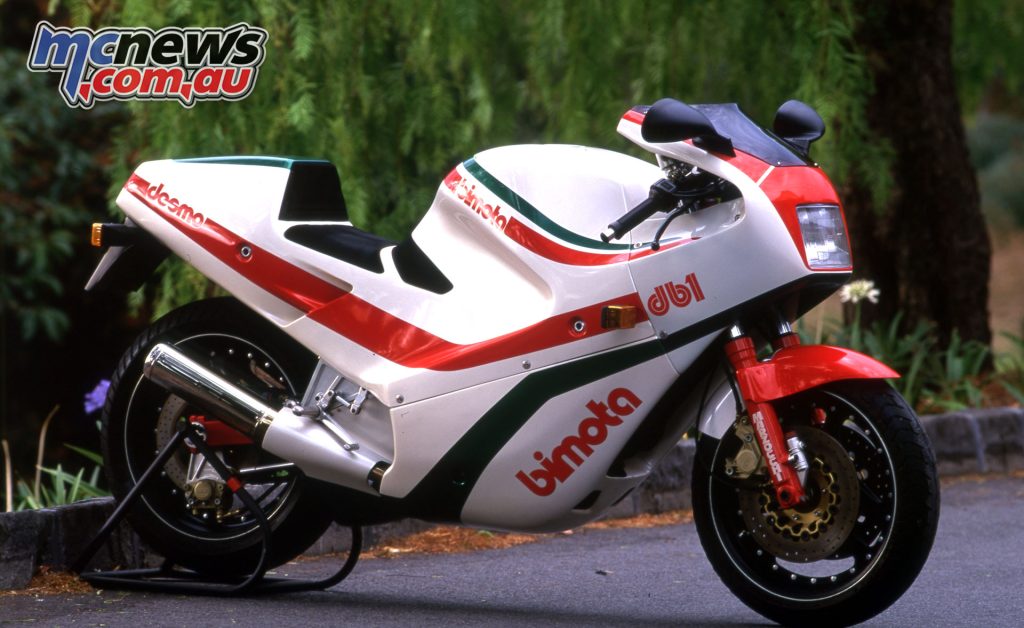
They went in two directions. Tamburini, who now worked for Cagiva, was commissioned to design and develop the radical Paso with its fully enveloped bodywork and redesigned engine, while the 750 F1 was updated. As part of Cagiva’s expansion plans, the Castiglionis also entered into an agreement with Bimota in 1985 to supply them 500 750 F1 engines during 1986, with additional units in subsequent years.
Martini first penned the DB1 in February 1985 as a racing bike, this being successfully raced in F1 events by Massimo Matteoni and Maurizio Rossi during the year. When it appeared as a street bike it was very closely based on the racer, much more so than Ducati’s own 750 F1.
The DB1 used a standard 1986 750 F1 engine, with a relocated oil cooler and a different air filtration system. This engine was one of Ducati’s best, and although it looked similar to the 1985 version was significantly improved.
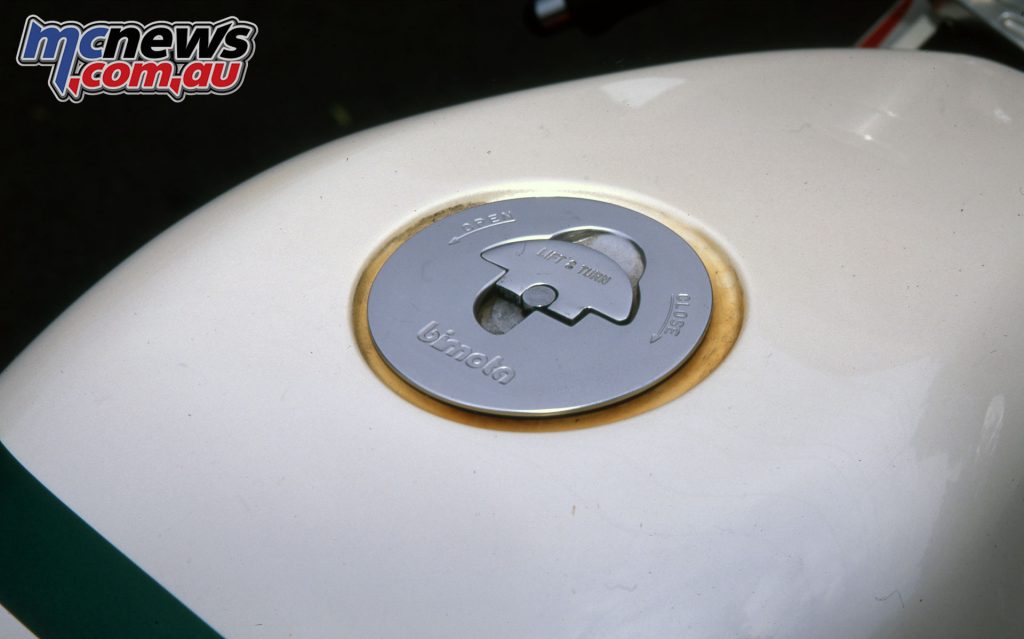
No longer was it merely an oversized 500. Following experience with racing F1s, the black-painted crankcases were strengthened with additional webbing between the drive side main bearing and gearbox main shaft bearing.
There were also important changes in the cylinder head. Finally larger valves came to go with the 88 mm pistons, a 41 mm inlet and 35 mm exhaust instead of the 500’s 37.5 mm inlet and 33.5 mm exhaust. There were also new camshafts, with less aggressive valve timing but increased lift.
Although the inlet ports remained unchanged, the Dell’Orto PHF 36 mm carburettors received new intake manifolds. Other engine updates included higher compression (10:1) pistons, stronger con-rods and a new forged crankshaft. The 1986 F1 also received a stronger gearbox, with 30% wider gears, and a new dry clutch.
A significant improvement over the 1985 model was in the oil cooling system. Rather than returning oil to each cylinder head the cooled oil returned to the right crankcase, just above the outlet.
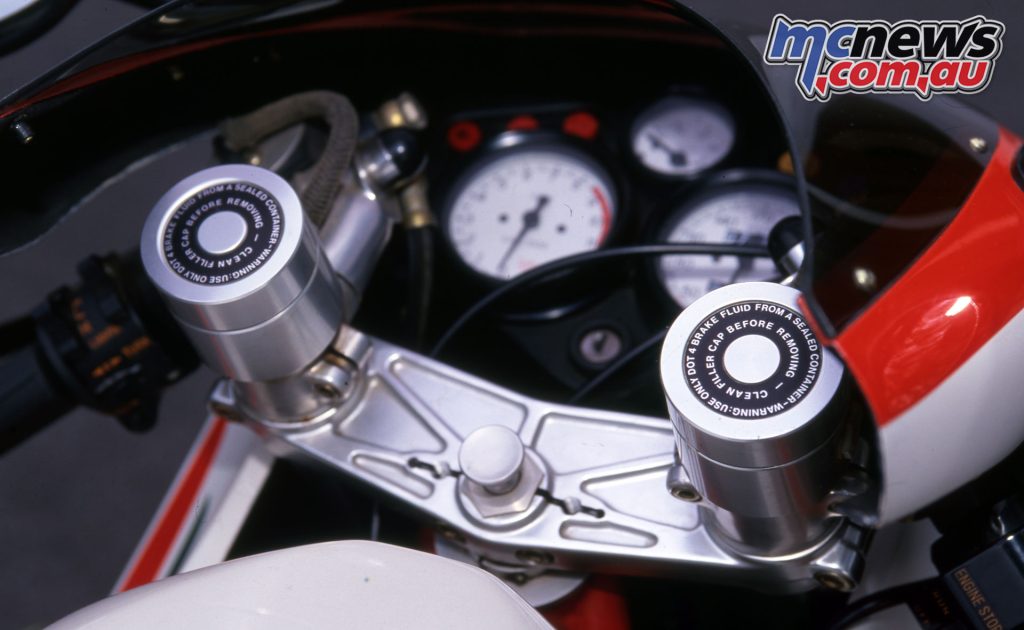
This system ensured that cool oil was supplied to the lower end of the engine, in addition to the cylinder heads. Not only was the 1986 engine a stronger design, the claimed power was considerably increased over the previous year, to 75 horsepower at 9,000 rpm, with 7.2 kgm of torque at 7,000 rpm.
In creating a frame for the Ducati engine Martini decided to make it as compact as possible. Thus the air cleaner element was tucked away in the rear section, requiring a long intake to the front 36mm Dell’Orto carburettor. It was mainly in the chassis and bodywork that the DB1 differed to the F1.
Although still utilising a tubular steel frame, Martini’s DB1 was significantly more compact than the Ducati, and rather more beautifully executed. With a steering head angle of 25-degrees the red-painted frame consisted only of straight tubing, formed in a series of triangles but not supporting the engine at the lower mount.
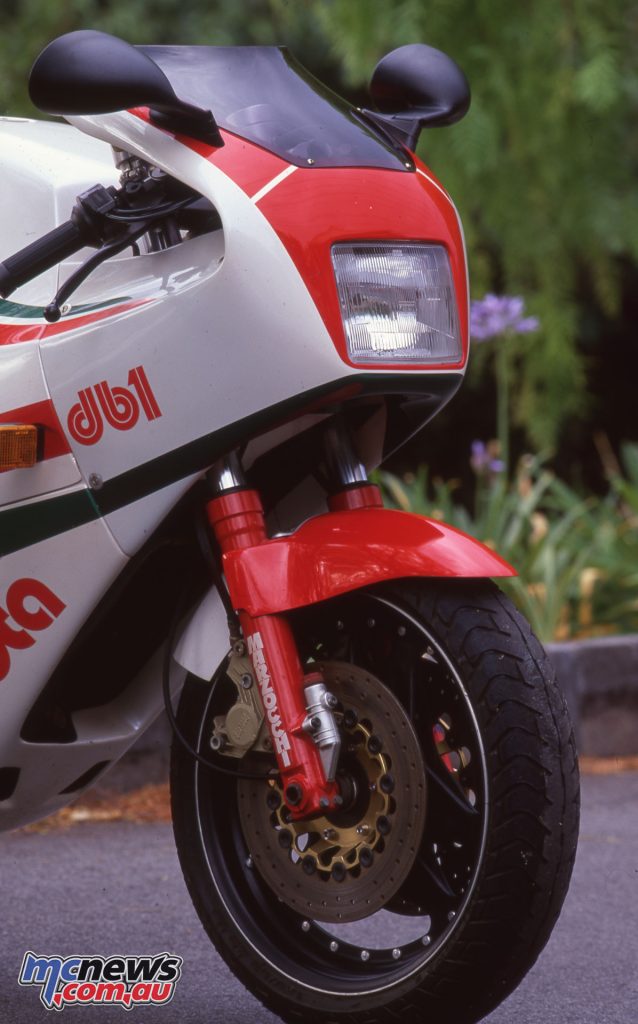
This left very little room for ancillary components, the battery, regulator, and ignition sitting above the engine, underneath the foam filled, plastic fuel tank.
Rather than the F1’s round-section steel swingarm, the DB1 featured a rectangular section steel swingarm that operated the single adjustable Marzocchi PVS4 shock absorber through a rising-rate linkage. Shock absorber damping was by a cable and knob attached to the swingarm, and chain adjustment was by eccentrics at the axle.
Front suspension was 41.7 mm Marzocchi M1R forks, state-of-the-art racing equipment for the day, with triple clamps machined from solid billets of “Avional 14”. Rolling on 16-inch Bimota composite alloy wheels front and rear (3.25 x 16-inch front and 4.25 x 16-inch rear) the DB1 was an extremely short and low motorcycle. The wheelbase was a mere 1380 mm, the seat height only 714 mm, and the claimed dry weight only 160 kg. This was significantly lighter than a standard 750 F1.
As on the F1, the front brakes were fully-floating 280mm cast-iron Brembo, but the DB1 included Brembo “Gold Series” 08 brake calipers. Other equipment was similar to the F1 but also of a higher quality. This included the milled and forged aluminium handlebars, footrest brackets, levers, and master cylinder reservoirs on the tops of the fork legs.
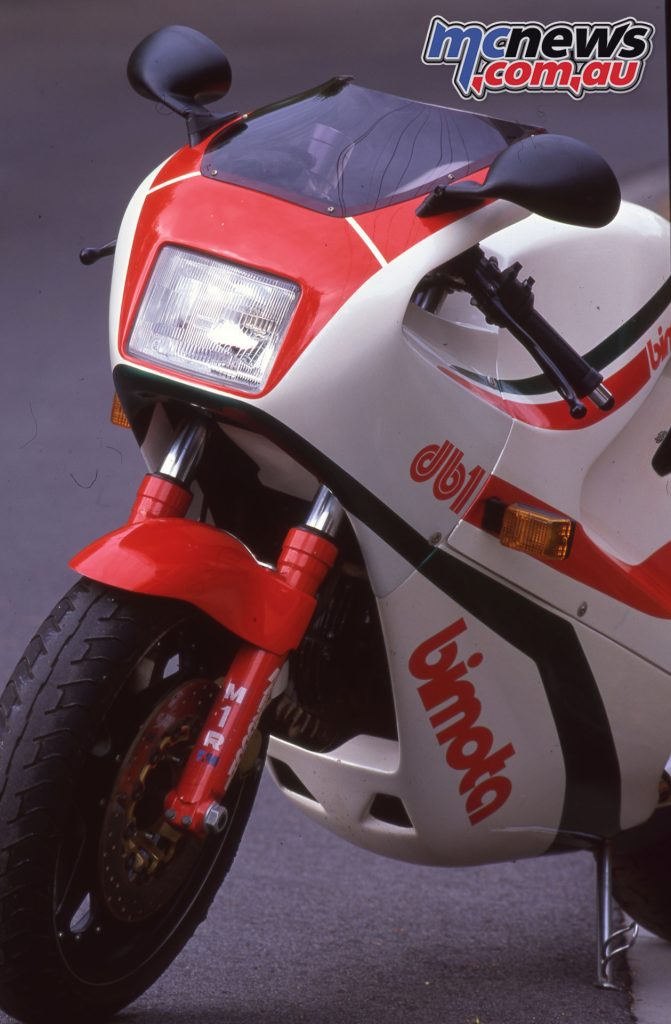
Probably the most striking feature of the DB1 was the totally enclosed fibreglass bodywork that not only fitted perfectly, but also was designed to come apart easily through a combination of Dzus-type fasteners and Allen screws. A higher performing DB1S was released in 1986, identical to the DB1 except for larger Dell’Orto 40-mm carburettors.
An even higher performance DB1 SR was available in 1987,this with Malossi 41mm carburettors, and a Ducati-NCR two-into-one aluminium exhaust system. The claimed power for was 80 horsepower at 9,200 rpm. Because the Japanese took to the DB1 with such alacrity, there was also a specific Japanese market DB1 J, with a six-speed 400 F3 engine.
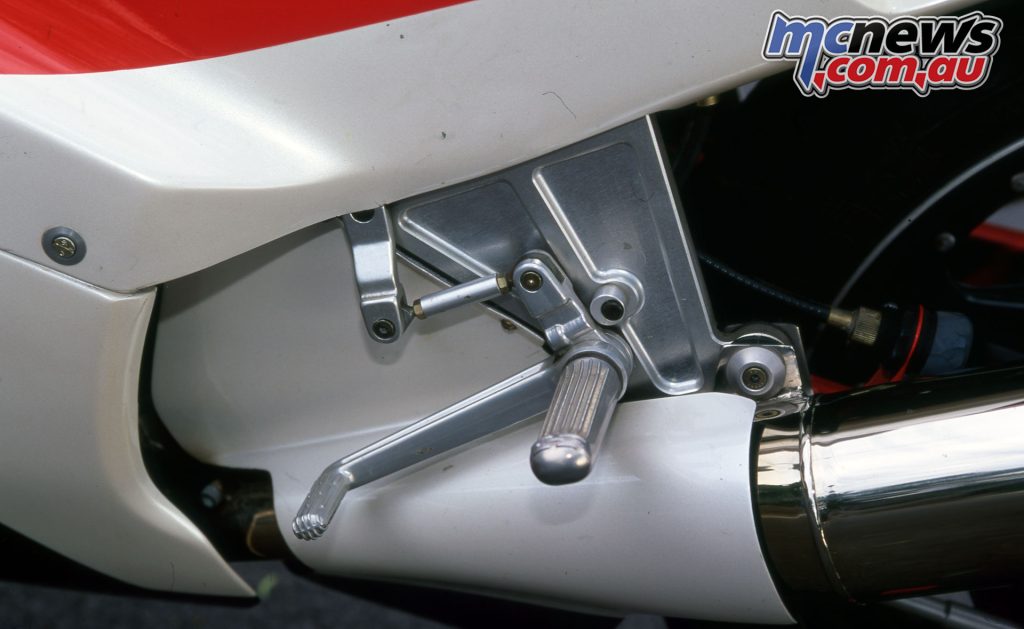
Before Bimota embarked on the DB1 project there had been a cloud over the future of the company but the DB1 was surprisingly successful. 453 were constructed, most of these going to Japan. Production ended as Ducati phased out the 750 F1, but the DB1 still saved Bimota from extinction in the late 1980s. The DB1 was the first all-Italian Bimota, and for many is still the most beautiful.
You can also check out Phil Aynsley’s take on the DB1 here:
Bimota DB1 | Ducati 750 Pantah F1 powered Bimota
1985-1986 Bimota DB1 Specifications
| 1985-1986 Bimota DB1 Specifications | |
| Engine | Four stroke, 90 degrees L twin cylinder, SOHC, desmodromic 2 valves per cylinder |
| Capacity | 748 cc |
| Bore x Stroke | 88 x 61.5 mm |
| Compression Ratio | 9.3:1 |
| Cooling System | Air cooled |
| Induction | Dual 36mm Dell’ Orto PHF36 carbs |
| Ignition | Bosch |
| Starting | Electric |
| Max Power | 46.6 kW (62.5 hp) @ 7500 rpm |
| Max Torque | 61 Nm (6.22 kgf-m / 45 lb-ft) @ 6500 rpm |
| Transmission | Five-Speed |
| Final Drive | Chain |
| Front Suspension | 41.7 mm / Telescopic M.1.R Marzocchi with four-way rebound damping |
| Rear Suspension | Rising rate linkage with Marzocchi shock with adjustable preload 11-position compression damping |
| Front Brakes | Brembo “Gold Series” 08 brake calipers, dual 280 mm discs |
| Rear Brakes | Single 260 mm disc |
| Front Tyre | 130/80 V16 |
| Rear Tyre | 160/80 V18 |
| Dry Weight | 160 kg |
| Fuel Capacity | 20 Litres |
| Top Speed | 220 km/h |























